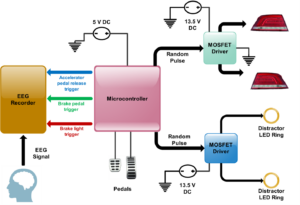The aim of the project is to evaluate the effectiveness of existing vehicle brake light designs, and identify factors that promote faster perception of the braking event. With this aim, the objectives are:
-
To develop electroencephalogram (EEG) response protocols and measurement algorithms that correctly represent visual stimuli recognition from LED brake light designs;
-
To evaluate existing LED brake light designs using the measure developed from objective 1;
-
To validate their performance under real driving conditions;
-
To analyse the differences in EEG (from objectives 2 and 3) between experienced and novice drivers to better understand the influence of experience in the braking response;
-
To publish LED brake design characteristic factors that promote faster driver perception, allowing manufacturers to develop new LED designs in future that are safer;
The experimental study required EEG data collection, time stamps for brake light ‘ON’ events, and time stamps for brake pedal press events. To meet these requirements, we developed a custom hardware platform with multiple event marker generation using a 32-bit microcontroller. A driving environment was simulated using a video projected behind the brake lights.
For the simulation of brake lights, the ten different brake lights were fitted (one at a time) on two adjustable stands equipped with small wooden mounting platforms of adjustable height. The lights were separated with an inner end-to-end distance of 120 cm, and at a height of 100 cm for all the different brake lights used in the experiment.
Biosemi EEG device was used to measure EEG data from channel Pz.
Each session was designed as a simulated driving paradigm with the brake light assembly in front of the participant representing a leading vehicle. Those brake lights were activated at random intervals. Subjects were instructed to continuously depress the accelerator pedal until they perceived an activation of the brake light in the simulated leading vehicle. At that point they were told to immediately release the accelerator and depress the brake pedal. They were asked to ignore any flashes or activations of the yellow distractor rings.
The experiment consisted of two sessions, taking place on separate days, each evaluating the efficacy of five different brake light configurations. The order of presentation of the lights was randomised across subjects. Data was recorded from a total of 22 volunteers. All possessed valid UK driving licenses and had normal or corrected-to-normal vision. Half of the subjects were classed as experienced drivers, with more than four years of driving experience. Ethics approval for all experiments were obtained from the Faculty of Science Research Ethics committee at the University of Kent.


